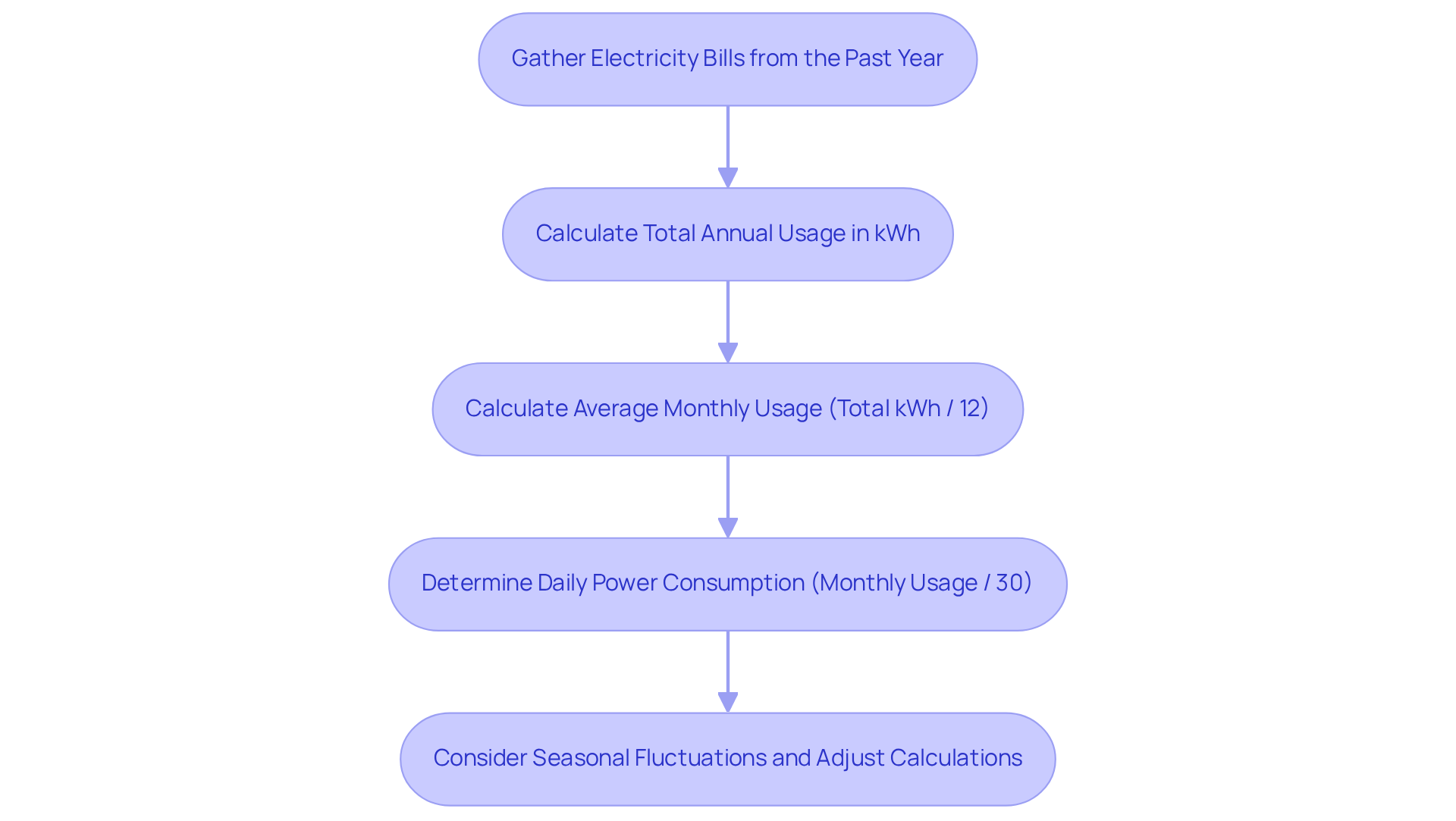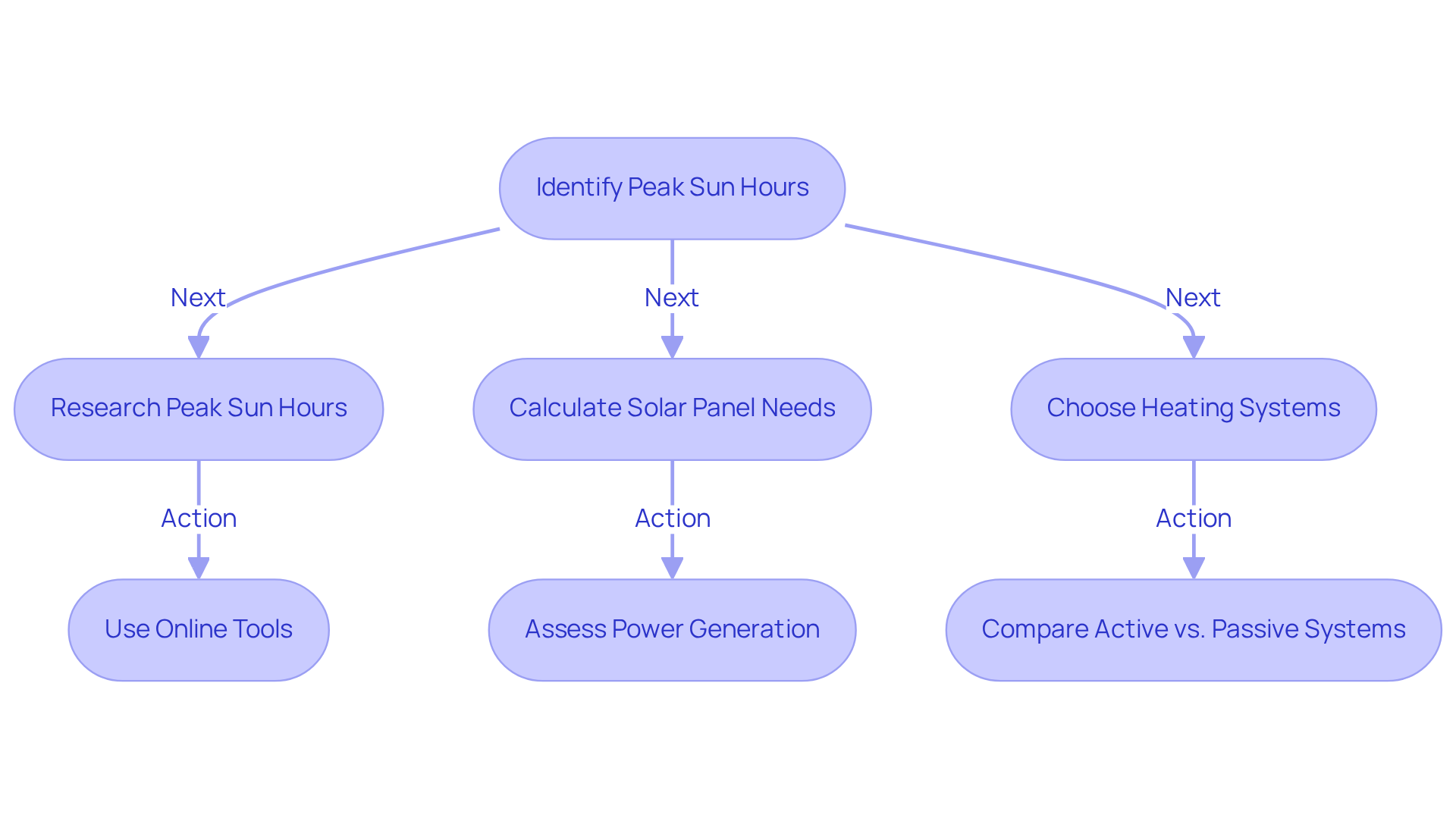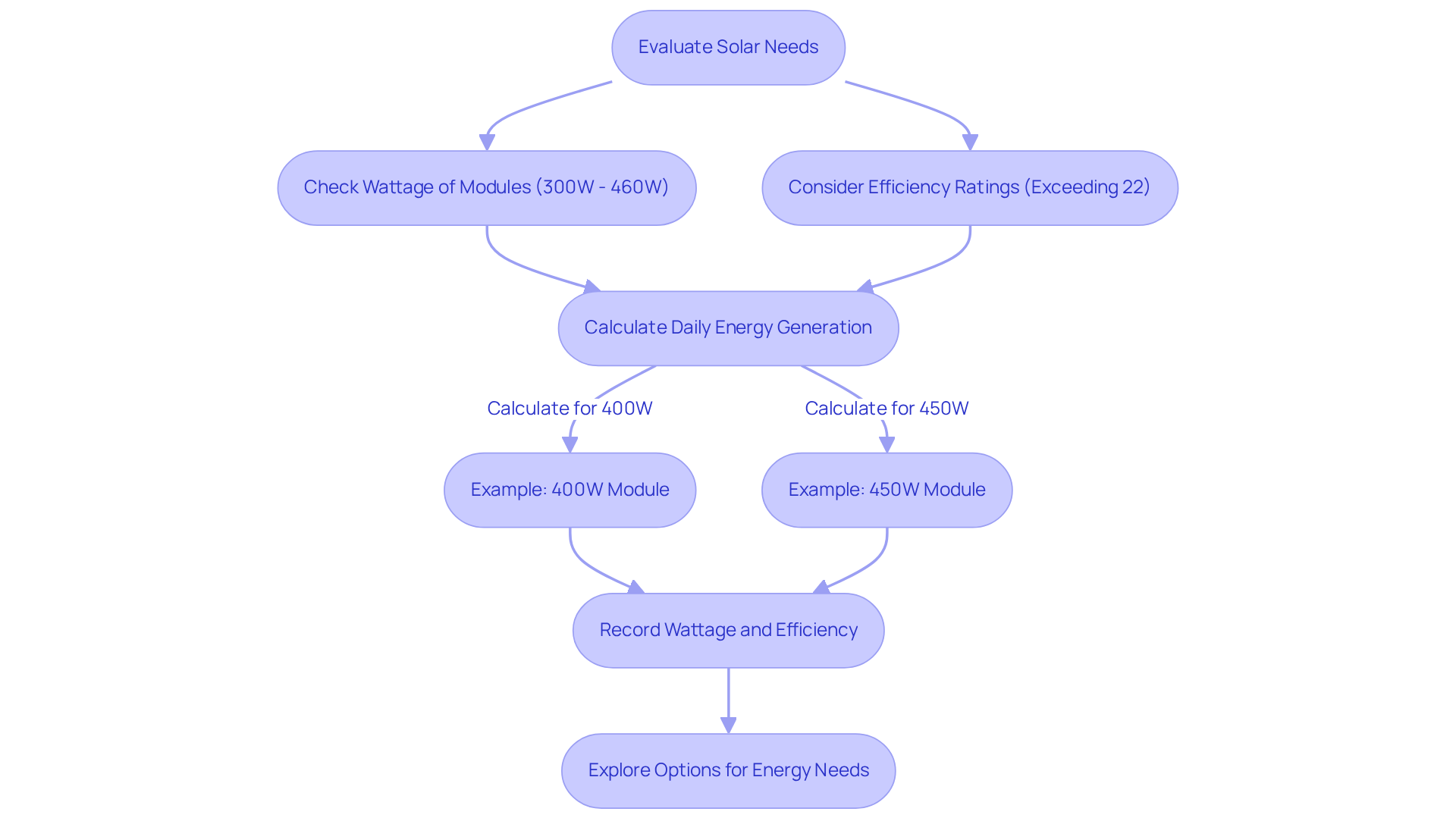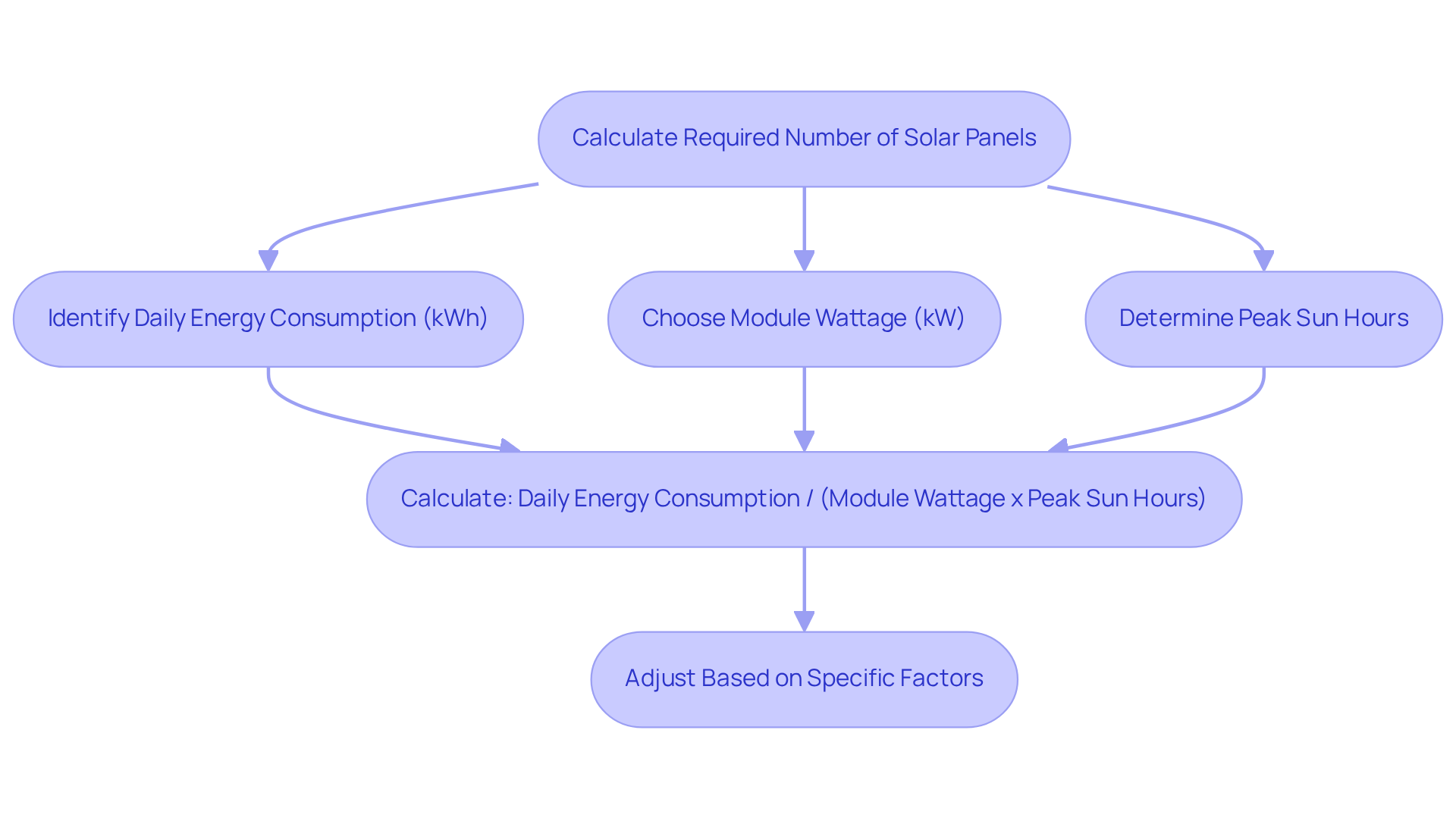Overview
As homeowners, it’s natural to worry about rising energy bills and the impact on your budget. To help ease these concerns, understanding your household energy consumption is the first step towards finding a sustainable solution. By identifying the peak sun hours in your location, you can begin to see how solar energy can work for you, providing not just savings but also a sense of energy independence.
Evaluating the efficiency and wattage of potential solar panels is crucial in this journey. Our step-by-step guide encourages you to:
- Gather your electricity bills
- Understand the availability of sunlight in your area
- Calculate the number of panels you may need based on your daily energy consumption and panel specifications
It’s common to feel overwhelmed by this process, but rest assured, we are here to support you every step of the way.
By making informed decisions tailored to your energy needs, you can take control of your energy future. Together, we can explore how solar energy not only benefits your finances but also contributes to a more sustainable world. Let’s work towards a brighter, greener future together!
Introduction
We understand that managing energy bills can be a significant concern for many homeowners. Understanding the intricacies of solar energy can empower you to take control of your energy consumption and costs. By learning how to calculate your solar panel needs, you can transition to a more sustainable lifestyle while potentially saving money.
It’s common to feel overwhelmed by the process, but rest assured, it involves several critical factors that can be navigated with the right support. From assessing your household energy usage to evaluating peak sun hours and panel efficiency, each step brings you closer to energy independence.
How can you ensure that your solar system is tailored to meet your unique energy demands? Together, we can explore these calculations and find the best solutions for your home.
Assess Your Household Energy Consumption
-
Begin by gathering your electricity bills from the past year. This will help you understand your total annual usage in kilowatt-hours (kWh). For homeowners in California, the average monthly electricity usage is around 571 kWh, which adds up to approximately 6,852 kWh annually. We understand that reviewing these numbers can feel daunting, but it’s an important step towards energy independence.
-
Next, calculate your average monthly usage. Simply divide your total annual consumption by 12. For example, if your total is 7,200 kWh, your average monthly usage would be 600 kWh. This knowledge empowers you to take control of your energy consumption.
-
To find out your daily power consumption, divide your monthly usage by 30. In our example, 600 kWh divided by 30 equals 20 kWh per day. This breakdown can help you reflect on your daily habits and how they contribute to your overall energy use.
-
It’s also essential to consider any seasonal fluctuations in your power usage. For instance, you might notice increased consumption during the summer months due to air conditioning or during winter for heating. By modifying your calculations accordingly, you can ensure a more accurate assessment of your power needs as you learn how to calculate solar panel needs for photovoltaic installation. Remember, together we can navigate these considerations to find the best solutions for your home.
Identify Your Location’s Peak Sun Hours
-
We understand that many homeowners are concerned about rising energy bills, and one way to alleviate this worry is by investigating your area’s typical peak sunlight hours. Utilizing online tools or energy calculators can be incredibly helpful. In California, for instance, most regions typically receive between 4 to 6 peak sun hours per day, with some areas, particularly in the desert southwest, reaching up to 7 to 8 hours. Understanding how to calculate solar panel needs based on these peak sunlight hours is vital for maximizing photovoltaic production, which is essential for assessing the effectiveness of your panels and their capacity to fulfill your power requirements.
-
Peak sun hours are identified as the times when sunlight intensity is adequate to produce maximum power, typically occurring around midday when the sun is at its highest position. This understanding is crucial for choosing the best batteries for efficient power storage, ensuring that your system can effectively capture and retain power for later use.
-
For example, if your region averages 5 peak sun hours, your photovoltaic systems can function at their rated capacity for 5 hours daily. This greatly influences your power generation. Understanding how to calculate solar panel needs is crucial for assessing the number of photovoltaic modules necessary to meet your power needs, especially when considering the financial and ecological advantages of these systems, including cost savings, job creation, and greenhouse gas reduction.
-
Additionally, it’s important to familiarize yourself with the types of heating systems available—active and passive. Active systems use pumps and controls to circulate heat transfer fluids, while passive systems rely on building design to optimize heat absorption. Understanding these systems can empower you to make informed decisions that align with your household needs and budget. Together, we can contribute to a sustainable and energy-efficient home. Keep this information in mind, as it will be vital for your upcoming calculations on how to calculate solar panel needs in relation to the number of photovoltaic modules required to fulfill your energy needs.
Evaluate Solar Panel Efficiency and Wattage
- We understand that managing energy bills can be a significant concern for homeowners. Start by learning how to calculate solar panel needs by investigating the wattage of the photovoltaic modules you are contemplating. In California, most residential solar systems generally range from 300W to 460W, with modern choices frequently generating between 400W and 450W.
- Next, consider the efficiency rating of the modules, which indicates the percentage of sunlight transformed into usable electricity. Higher efficiency modules, often exceeding 22%, can generate more energy in limited space, making them ideal for homes with smaller roofs.
- For instance, if you choose a 400W module with an efficiency of 20%, it can generate roughly 1.6 kWh each day under ideal conditions (400W x 5 hours of peak sun). In contrast, a 450W module with an efficiency of 22.3% could yield around 2 kWh daily, showcasing the benefits of higher wattage and efficiency.
- Record the wattage and efficiency of the modules you are evaluating, as this information will be essential for understanding how to calculate solar panel needs and possible savings. Together, we can explore these options and find the best solution for your energy needs.
Calculate Your Required Number of Solar Panels
Are you concerned about your energy bills? Understanding how to calculate solar panel needs for your home can be a significant step towards achieving energy independence. To assist you in understanding how to calculate solar panel needs, you can use the following formula:
Required Number of Modules = Daily Energy Consumption (kWh) / (Module Wattage (kW) x Peak Sun Hours).
For example, if your daily energy consumption is 20 kWh and you choose a 400W panel with 5 peak sun hours, the calculation would be:
- 20 kWh / (0.4 kW x 5 hours) = 10 panels.
This means you would need 10 photovoltaic panels to meet your daily power needs. However, it’s essential to adjust this number based on how to calculate solar panel needs according to your specific power consumption patterns. Consider factors like shading from trees or the available roof space.
We understand that navigating these calculations can feel overwhelming. Consulting with renewable power specialists can provide you with personalized insights tailored to your unique circumstances. This ensures that your system is optimally sized for both your current and future power requirements. Real-world examples show that many homeowners discover their required panel quantities fluctuate based on lifestyle changes—such as adding electric vehicles or increasing appliance usage. By recognizing these dynamics, you can make informed decisions about your solar energy investment, paving the way for a sustainable future together.
Conclusion
Understanding how to calculate solar panel needs is a crucial step on the journey toward energy independence and reducing those monthly electricity bills that can often feel overwhelming. By accurately assessing your household energy consumption, recognizing peak sun hours, evaluating solar panel efficiency, and calculating the required number of panels, you can make informed decisions that align with your energy goals and aspirations.
We know that reviewing past electricity bills can be daunting, but it’s an important way to gauge your total energy usage. It’s also essential to recognize how peak sunlight hours impact solar panel output and to consider the efficiency and wattage of the solar modules you choose. These factors collectively influence the overall effectiveness of a solar power system and its ability to meet your unique energy demands.
As our world increasingly embraces renewable energy sources, taking the initiative to calculate your solar panel needs not only empowers you but also contributes to a more sustainable future for us all. Engaging with renewable energy specialists can further enhance this process, ensuring that your system is tailored to your specific needs and can adapt to future changes. Embracing solar energy is not just a personal investment; it is a meaningful step toward a greener planet, and together, we can make a difference.






